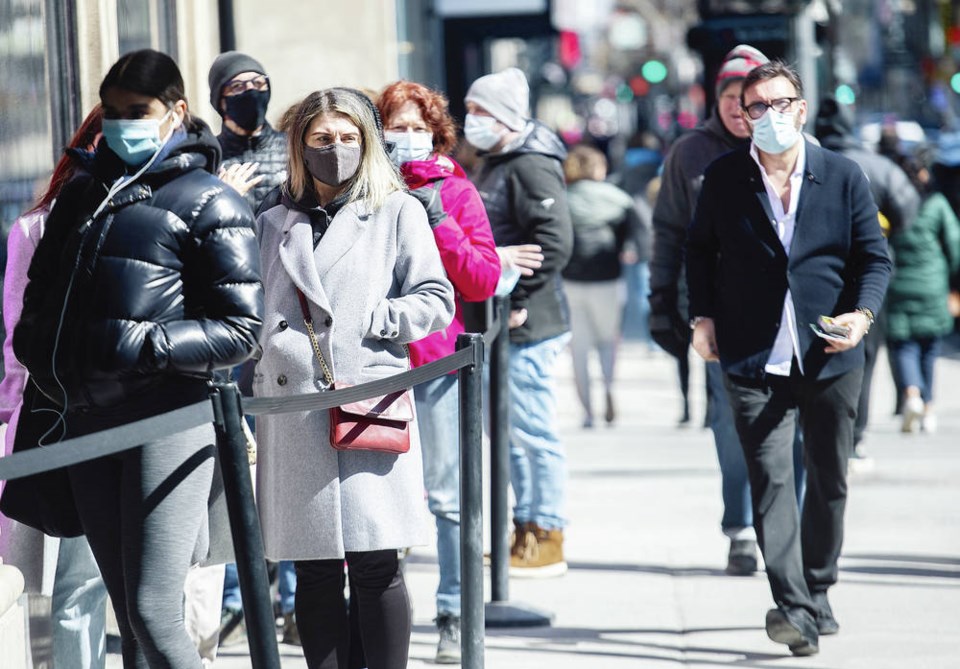Three of the provinces hardest-hit by COVID-19 spent their second pandemic-era Good Friday either adjusting to or bracing for stricter public health measures meant to bring resurgent case counts back in check.
Three regions of Quebec, including the provincial capital, are under a 10-day lockdown that took effect hours before the province reported the highest daily case load since late January.
On Wednesday, sa���ʴ�ý imposed what it called a three-week-long “circuit breaker” hoping to “break the chain of COVID-19 transmission.”
Ontario will pull what it dubs an “emergency brake” at midnight for the entire province, forcing the closing of personal services and in-person dining while imposing tighter capacity limits on both essential and non-essential businesses. The move came in response to modelling that showed case counts could top 6,000 a day by month’s end without intervention.
While the problem in all three provinces is the same — faster-spreading variants and rising hospitalizations — the rules are all slightly different.
Quebec closed schools in the affected regions while Ontario and sa���ʴ�ý did not.
All three are prohibiting indoor gatherings at private residences, but Quebec is also banning outdoor gatherings at homes and cottages. Ontario and sa���ʴ�ý both say it’s safe to allow up to 10 people to assemble outside.
Quebec’s rules include a curfew banning people from leaving their homes between 9:30 p.m. and 5 a.m. in most regions, though the start of the curfew has been moved back to 8 p.m. in the province’s three newly locked-down cities.
Residents of Quebec City, Levis and Gatineau will also see schools close and non-essential business shut down for at least 10 days in a bid to bring soaring local case counts back under control.
Elsewhere, Quebec allows up to 250 people inside a place of worship as long as they can maintain a two metre distance from others. But the number differs for weddings and funerals, where the limit is 25 attendees.
British Columbia only allows worship outdoors, up to a maximum of 50 people, plus two more to enforce the rules. In Ontario, worship services are limited to 15 per cent capacity.
A new survey suggested Canadians navigating the complex patchwork of public health measures are likely to disregard them altogether and even ignore nearly universal calls from public health officials and politicians to skip Easter gatherings this year.
Tofino, on the Island’s west coast, traditionally sees of visitors on the Easter weekend. Mayor Dan Law said he was seeing tourists arriving, “though our community seems far less busy than in a normal year.”
Law said he is hearing from the business community that the provincial health officer’s restrictions on indoor dining are having an impact on visitor numbers. “Many accommodation providers remain closed, and many that are open are refusing out-of-region bookings,” said Law.
“As a district, we are following recommendations, staying safe, while also rallying around our local businesses by ‘buying local’ and actively supporting local restaurants,” said the mayor.
The district is “very pleased” with Island Health’s whole community vaccine delivery approach for small and remote communities that will see everyone in Tofino offered COVID-19 vaccinations on April 12, said Law. He hopes that will provide an effective “reset” for the community and help towards a speedy recovery from the pandemic throughout sa���ʴ�ý
An online poll done by Leger for the Association for Canadian Studies and the University of Manitoba found more than 40 per cent of the people surveyed feel safe attending family gatherings at this point, and a quarter believe the government is overhyping the dangers of COVID-19.
Toronto mother Marcia Martins said she is scaling back her family’s usually large Easter gathering to just four households this year, noting the move feels safe since most attendees don’t work outside the home. “These are just difficult times right now,” she said. “And I’m just glad that there’s a way that we can just keep as close to normal — or what our old normal was.”
— With Cindy E. Harnett, sa���ʴ�ý
